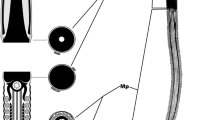Summary
A comparison among the sperm of eight species of teredos, four of which fertilize the eggs in the mantle cavity and four of which do not, revealed that externally fertilizing sperm have larger acrosomes and longer acrosomal rods than do internally fertilizing sperm.
Similar content being viewed by others
References
Colwin, A. L., Colwin, L. H.: Role of the gamete membranes in fertilization. In: Cellular membranes in development, p. 233–279 (M. Locke, ed.). New York: Academic Press 1964
Colwin, L. H., Colwin, A. L.: Membrane fusion in relation to sperm-egg association. In: Fertilization, vol. 1, chapter 7, p. 295–367, (C. B. Metz and A. Monroy, eds.). New York: Academic Press 1967
Dan, J. C.: The vitelline coat of the Mytilus egg. I. Normal structure and effect of acrosomal lysin. Biol. Bull. 123, 531–541 (1962)
Dan, J. C.: Acrosome reaction and lysins. In: Fertilization, vol. 1, chapter 6, p. 237–293 (C. B. Metz and A. Monroy, eds.). New York: Academic Press 1967
Fawcett, D. W.: A comparative view of sperm ultrastructure. Biol. Reprod., Suppl. 2, 90–127 (1970)
Franzen, Å.: Comparative morphological investigation into the spermiogenesis among molluscs. Zool. Bidr. Uppsala, 30, 399–456 (1956)
Franzen, Å.: Phylogenetic aspects of the morphology of spermatozoa and spermiogenesis. In: Comparative spermatology, p. 29–46, (B. Bacceti, ed.). Accademia Nazionale dei Lincei-Roma 1971
Popham, J. D.: Ultrastructure of gametes in Bankia australis and other teredos. Ph. D. thesis, University of New South Wales (1974) (to be submitted)
Popham, J. D., Dickson, M. R., Goddard, C. K.: Ultrastructural study of the mature gametes of two species of Bankia (Teredinidae, Mollusca). Aust. J. Zool. 22, 1–12 (1974)
Reynolds, E. S.: The use of lead citrate at high pH as an electron opaque stain in electron microscopy. J. Cell Biol. 17, 208–212 (1963)
Townsley, P. M., Ricky, R. A., Trussel, P. C.: The laboratory rearing of the shipworm, Bankia setacea (Tryon). Proc. Nat. Shellfisheries Assoc. 56, 49–52 (1965)
Turner, R. D.: A survey and illustrated catalogue of the Teredinidae, 265 pp. Harvard: Museum of Comparative Zoology (1966)
Turner, R. D.: Identification of marine wood-boring molluscs. In: Marine borers, fungi and fouling organisms of wood, chapter 1, p. 17–64, (E. B. G. Jones and S. K. Eltringham, eds.). Paris: Organisation for Economic Co-operation and Development 1971
Underwood, E. E.: Quantitative stereology, 274 pp. Reading, Massachusetts: Addison-Wesley Publishing Co. 1970
Author information
Authors and Affiliations
Additional information
The author would like to express his gratitude to Doctor M. R. Dickson and Doctor C. K. Goddard for their helpful suggestions and comments, and to Mr. A. B. Martin and Mrs. J. Campbell for their technical assistance.
Rights and permissions
About this article
Cite this article
Popham, J.D. Comparative morphometrics of the acrosomes of the sperms of “externally” and “internally” fertilizing sperms of the shipworms (teredinidae, bivalvia, mollusca). Cell Tissue Res. 150, 291–297 (1974). https://doi.org/10.1007/BF00220138
Received:
Issue Date:
DOI: https://doi.org/10.1007/BF00220138




